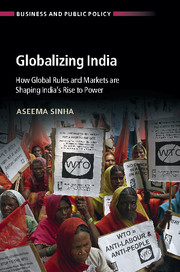Book contents
- Frontmatter
- Dedication
- Contents
- List of figures
- List of tables
- Preface and acknowledgments
- Note on currency translation
- List of abbreviations
- 1 How global rules and markets are shaping India's rise to power
- 2 A theory of causal mechanisms and Global Design-in-Motion
- 3 Trade, statecraft, and state capacity in India
- 4 Realigning interests toward global reach: Changes in India's pharmaceutical sector
- 5 Mobilizing new interests and tying the state's hands: Decline and revival in the textile sector
- 6 Interests in motion: Private sector change in India's textile sector
- 7 Mechanisms of change within global markets
- 8 Conclusion
- Appendix: Field trips, and list of interviews, and libraries visited
- References
- Index
8 - Conclusion
Published online by Cambridge University Press: 05 April 2016
- Frontmatter
- Dedication
- Contents
- List of figures
- List of tables
- Preface and acknowledgments
- Note on currency translation
- List of abbreviations
- 1 How global rules and markets are shaping India's rise to power
- 2 A theory of causal mechanisms and Global Design-in-Motion
- 3 Trade, statecraft, and state capacity in India
- 4 Realigning interests toward global reach: Changes in India's pharmaceutical sector
- 5 Mobilizing new interests and tying the state's hands: Decline and revival in the textile sector
- 6 Interests in motion: Private sector change in India's textile sector
- 7 Mechanisms of change within global markets
- 8 Conclusion
- Appendix: Field trips, and list of interviews, and libraries visited
- References
- Index
Summary
This book analyzes globalization by unveiling the architecture and agents of globalization. How does globalization actually work? Who are the actors and agencies that implement the various tasks of globalization? Through what exact mechanisms does it affect nations, firms, and individuals? Globalization does not emerge on its own but is created by the activities of individuals and firms as they interact with states, international organizations, and collective associations. This interaction is not only mediated by markets and prices but also shaped by rules enforced by international organizations as well as cooperative learning and information sharing among states and firms. This book also challenges the idea that actions originating from either the domestic or the global level are primary or autonomous. The impact of global economic flows and rules depends on the actions and responses of domestic actors, but these actors and institutions are faced with a changed global environment that affects their domestic and external strategies.
What do global forces do? Global forces nudge recalcitrant states to comply not only through coercion or pressure but also through legally framed sovereignty costs. Implementing international agreements is costly and creates onerous transaction and implementation costs, which under some conditions can lead to a building of state capacity, new tradecraft, and new state–society mechanisms of consultation. This may contribute to better negotiation outcomes and the combined use of free-trade and protectionist measures. Contrary to conventional wisdom, globalization rests not only on competition or price signals but also on involuntary nonmarket mechanisms. Three such mechanisms – public information revealed by state and international organizations, learning abilities of states and firms to manage global challenges in an interdependent as well as a competitive context, and economic threats that originate outside the national boundaries of states – played a major role in nudging Indian capital to become global.
Where do these nonmarket mechanisms of globalization come from? This book finds that global rules of the game, and agreements enshrined in international organizations such as the WTO, have created new nonmarket mechanisms that are as important as global markets and economic flows in shaping domestic politics of nations around the world. The effects of such mechanisms and the strategies by domestic actors can be understood with the help of the Global Design-in-Motion framework articulated in this book.
- Type
- Chapter
- Information
- Globalizing IndiaHow Global Rules and Markets are Shaping India's Rise to Power, pp. 272 - 287Publisher: Cambridge University PressPrint publication year: 2016

